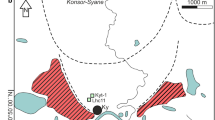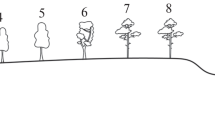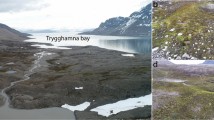Abstract
Testate amoebae are widely used in palaeoecological studies as indicators (proxies) of environmental conditions in mires and freshwater ecosystems. The goal of this work was to identify patterns in the dynamics of the species composition of testate amoeba assemblages during a “waterbody–mire” succession. This study was performed using multiproxy analysis of the deposits in Mochulya Bog, Kaluga oblast, European Russia. To explain changes in the species composition of testate amoebae, we used data on the plant macrofossil composition, peat humification, and the loss on ignition, together with the results of radiocarbon dating and pollen analysis. The deposit was formed by the sediments of the waterbody, with rich fen and poor fen. The age at the base of the deposits was 4100 cal. yr. BP. Changes in the species composition of testate amoeba assemblages were largely determined by local vegetation, especially Sphagnum mosses, which significantly transform the environment. The transformation of the waterbody into a rich fen may have most likely occurred as a result of climatic (allogeneic) factors: short-term drying and wildfires that might have led to the overgrowth of the shore. The transformation of the rich fen to a poor fen could have been related to the effects of both autogenic (accumulation of the deposits) and allogeneic factors (decrease in human activity in the adjacent area).




Similar content being viewed by others
REFERENCES
Beug, H.J., Leitfaden der Pollenbestimmung für Mitteleuropa und angrenzende Gebiete, Munich: Verlag Friedrich Pfeil, 2004.
Blaauw, M., Methods and code for ‘classical’ age-modelling of radiocarbon sequences, Quat. Geochronol., 2010, vol. 5, no. 5, pp. 512–518.
Blaauw, M. and Christen, J.A., rbacon: Age-depth modelling using Bayesian statistics, R package version 2.3.9.1, 2019. https://CRAN.R-project.org/package=rbacon.
Bobrov, A.A., Historical dynamics of lake-bog ecosystems and succession of testate amoebae (Testacea), Zool. Zh., 2003, vol. 82, no. 2, pp. 215–223.
Booth, R.K., Ireland, A.W., LeBoeuf, K., and Hessl, A., Late Holocene climate-induced forest transformation and peatland establishment in the central Appalachians, Quat. Res., 2016, vol. 85, pp. 204–210.
Bray, J.R. and Curtis, J.T., An ordination of the upland forest communities of southern Wisconsin, Ecol. Monogr., 1957, vol. 27, no. 4, pp. 325–349.
Chambers, F.M., Beilman, D.W., and Yu, Z., Methods for determining peat humification and for quantifying peat bulk density, organic matter and carbon content for palaeostudies of climate and peatland, Mires Peat, 2010, vol. 7, pp. 1–10.
Chambers, F.M., Booth, R.K., De Vleeschouwer, F., Lamentowicz, M., Le Roux, G.G., et al., Development and refinement of proxy-climate indicators from peats, Quat. Int., 2012, vol. 268, pp. 21–33.
Dean, W., Jr., Determination of carbonate and organic matter in calcareous sediments and sedimentary rocks by loss on ignition: comparison with other methods, J. Sediment. Res., 1974, vol. 44, pp. 242–248.
Elliott, S.M., Roe, H.M., and Patterson, R.T., Testate amoebae as indicators of hydroserial change: an 8500 year record from Mer Bleue Bog, eastern Ontario, Canada, Quat. Int., 2012 vol. 268, pp. 128–144.
Fiziko-geograficheskoe raionirovanie Nechernozemnogo tsentra (Physical and Geographical Regionalization of the Non-Chernozem Center), Gvozdetskii, N.A. and Zhuchkova, V.K., Eds., Moscow: Mosk. Univ., 1963.
Gel’tser, Yu.G., Korganova, G.A., and Alekseev, D.A., Prakticheskoe rukovodstvo po identifikatsii pochvennykh testatsii (A Practical Guide to the Identification of Soil Testate Amoebae), Moscow: Mosk. Univ., 1985.
Gilbert, D., Amblard, C., Bourdier, G., Francez, A.J., and Mitchell, E.A.D., Le régime alimentaire des thécamoebiens, L’Année Biologique, 2000, vol. 39, pp. 57–68.
Gomaa, F., Mitchell, E.A., and Lara, E., Amphitremida (Poche, 1913) is a new major, ubiquitous labyrinthulomycete clade, PLoS One, 2013, vol. 8. e53046.
Goring, S., Williams, J.W., Blois, J.L., Jackson, S.T., Paciorek, C.J., et al., Deposition times in the northeastern United States during the Holocene: establishing valid priors for Bayesian age models, Quat. Sci. Rev., 2012, vol. 48, pp. 54–60.
Grimm, E.C., CONISS: a FORTRAN 77 program for stratigraphically constrained cluster analysis by the method of incremental sum of squares, Comput. Geosci., 1987, vol. 13, pp. 13–35.
Harnish, O., Studien zur Okologie und Tiergeographie der Moore, Zool. Jahrbücher. (Abt. Syst.), 1925, vol. 51, pp. 1–166.
Ireland, A.W. and Booth, R.K., Hydroclimatic variability drives episodic expansion of a floating peat mat in a North American kettlehole basin, Ecology, 2011, vol. 92, no. 1, pp. 11–18.
Juggins, S., rioja: Analysis of quaternary science data, R package version 0.9-15.1, 2017. http://cran.r-project.org/package=rioja.
Mazei, Yu.A. and Embulaeva, E.A., Changes in communities of soil testate amoebae along the forest-steppe gradient in the Middle Volga region, Arid. Ekosist., 2009, vol. 15, pp. 13–23.
Mazei, Yu.A. and Tsyganov, A.N., Presnovodnye rakovinnye ameby (Freshwater Testate Amoebae), Moscow: Tovarishchestvo nauchnykh izdanii KMK, 2006.
Mil’kov, F.N. and Gvozdetskii, N.A., Fizicheskaya geografiya SSSR. Obshchii obzor. Evropeiskaya chast’ SSSR. Kavkaz (Physical Geography of the USSR. General Review. European Part of the USSR. Caucasus), Moscow: Mysl’, 1976.
Mitchell, E.A.D., Charman, D.J., and Warner, B.G., Testate amoebae analysis in ecological and paleoecological studies of wetlands: past, present and future, Biodiversity Conserv., 2008, vol. 17, pp. 2115–2137.
Moore, P.D., Webb, J.A., and Collinson, M.E., Pollen Analysis, Oxford: Blackwell, 1991.
Novenko, E.Y., Tsyganov, A.N., Mazei, N.G., Kupriyanov, D.A., Rudenko, O.V., et al., Palaeoecological evidence for climatic and human impacts on vegetation in the temperate deciduous forest zone of European Russia during the last 4200 years: a case study from the Kaluzhskiye Zaseki Nature Reserve, Quat. Int., 2019, vol. 516, pp. 58–69.
Oksanen, J., Blanchet, F.G., Friendly, M., Kindt, R., Legendre, P., et al., vegan: Community Ecology Package, R package version 2.5-4, 2019. https://CRAN.R-project.org/package=vegan.
Patterson, R.T., Dalby, A., Kumar, A., Henderson, L.A., and Boudreau, R.E.A., Arcellaceans (thecamoebians) as indicators of land-use change: settlement history of the Swan Lake area, Ontario as a case study, J. Paleolimnol., 2002, vol. 28, p. 297e–316e.
Payne, R.J., Testate amoeba response to acid deposition in a Scottish peatland, Aquat. Ecol., 2010, vol. 44, no. 2, pp. 373–385.
Payne, R.J., Can testate amoeba-based palaeohydrology be extended to fens?, J. Quat. Sci., 2011, vol. 26, no. 1, pp. 15–27.
Payne, R.J., Malysheva, E.A., Tsyganov, A.N., Pampura, T.V., Novenko, E.Y., et al., A multi-proxy record of Holocene environmental change, peatland development and carbon accumulation from Staroselsky Moch Peatland, Russia, Holocene, 2016, vol. 26, no. 2, pp. 314–326.
R Core Team, R: A Language and Environment for Statistical Computing, R Foundation for Statistical Computing, Vienna, Austria, 2018. URL https://www.R-project.org/.
Reille, M., Pollen et spores d’Europe et d’Afrique du Nord, Marseille: Laboratoire de Botanique Historique et Palynologie, 1992.
Reimer, P.J., Bard, E., Bayliss, A., Beck, J.W., Blackwell, P.G., et al., IntCal13 and Marine13 radiocarbon age calibration curves 0—50,000 years cal BP, Radiocarbon, 2013, vol. 55, no. 4, pp. 1869–1887.
Ryding, H. and Juglum, J., The Biology of Peatlands, Oxford: Oxford Univ. Press, 2006.
Schönborn, W.E., Studies on remains of Testacea in cores of the Great Woryty Lake (NE Poland), Limnologica, 1984, vol. 16, pp. 185–190.
Simpson, G.L. and Oksanen, J., analogue: Analogue matching and Modern Analogue Technique transfer function models, R package version 0.17-1, 2018. https://cran.r-project.org/package=analogue.
Smirnova, O.V., Bobrovsky, M.V., Khanina, L.G., Braslavskaya, T.Yu., Starodubtseva, E.A., et al., Nemoral forests, in European Russian Forests. Their Current State and Features of Their History, Smirnova, O.V., Bobrovsky, M.V., and Khanina, L.G., Eds., Springer Netherlands, 2017, pp. 337–480.
Sonnenburg, E.P., Boyce, J.I., and Reinhardt, E.G., Multi-proxy lake sediment record of prehistoric (Paleoindian-Archaic) archaeological paleoenvironments at rice lake, ontario, canada, Quat. Sci. Rev., 2013, vol. 73, pp. 77–92.
Sukachev, V.N., Bolota, ikh obrazovanie, razvitie i svoistva (Bogs, Their Formation, Development, and Properties), Leningrad: Lesn. Inst., 1926.
Tolonen, K., Stratigraphic and rhizopod analyses on an old raised bog, Varrassuo, in Hollola, South Finland, Ann. Bot. Fenn., 1966, vol. 3, pp. 147–166.
Tyuremnov, S.N., Atlas rastitel’nykh ostatkov, vstrechaemykh v torfe (Atlas of Plant Residues Found in Peat), Moscow: Gosenergoizdat, 1959.
Volkova, E.M., Swamping of karst and karst-suffosion depressions in the Tula oblast, in Napravleniya issledovanii v sovremennom bolotovedenii Rossii (Directions of Research in Modern Bog Science of Russia), Yurkovska, T.K., Ed., St. Petersburg, 2010, pp. 146–163.
Volkova, E.M., Bogs of the Central Russian Upland: genesis, structural and functional features, and nature conservation value, Doctoral (Biol.) Dissertation, Tula: Tula State Univ., 2018.
Warner, B.G. and Charman, D.J., Holocene changes on a peatland in Northwestern Ontario interpreted from testate amoebae (Protozoa) analysis, Boreas, 1994, no. 23, pp. 270–279.
Funding
This study was carried out with financial support of the Russian Science Foundation (project no. 19-14-00102 for statistical analysis and writing the paper), the Russian Foundation for Basic Research (project no. 17-04-00320 for microscopic analysis of testate amoebae), and within the framework of a State Assignment of the Ministry of Science and Higher Education to Penza State University (project no. 6.7197.2017/BP for analysis of the degree of peat humification).
Author information
Authors and Affiliations
Corresponding authors
Ethics declarations
The authors declare that they have no conflict of interest. This article does not contain any studies involving animals or human participants performed by any of the authors.
Additional information
Translated by D. Pavlov
Rights and permissions
About this article
Cite this article
Tsyganov, A.N., Komarov, A.A., Mazei, N.G. et al. Dynamics of the Species Structure of Testate Amoeba Assemblages in a Waterbody-to-Mire Succession in the Holocene: A Case Study of Mochulya Bog, Kaluga Oblast, Russia. Biol Bull Russ Acad Sci 48, 938–949 (2021). https://doi.org/10.1134/S106235902107030X
Received:
Revised:
Accepted:
Published:
Issue Date:
DOI: https://doi.org/10.1134/S106235902107030X




